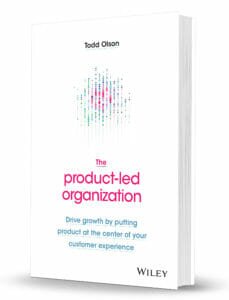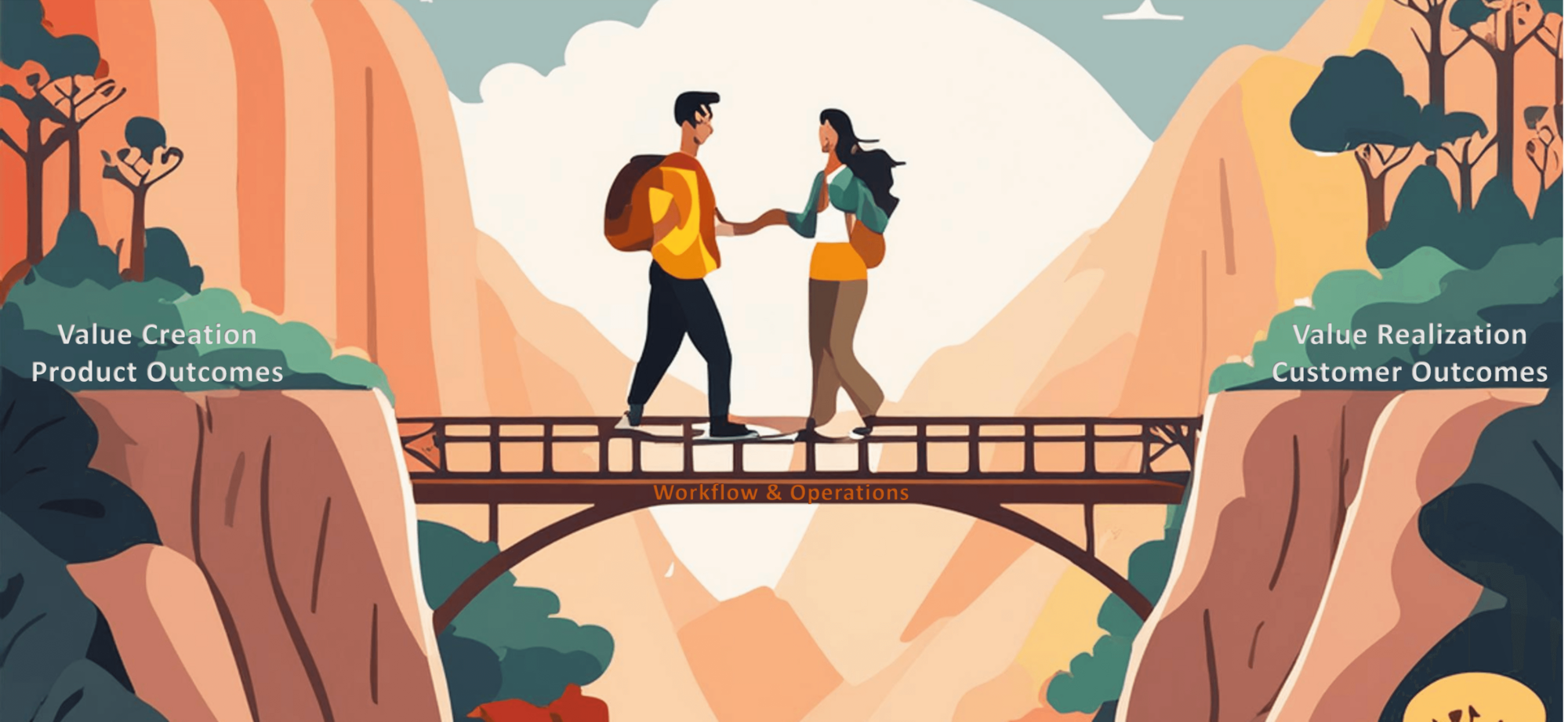
The Rise of the Product-Led Company
By Todd Olson, CEO and co-founder of Pendo
Product-led strategy wasn’t always as prevalent as it’s become more recently. Here’s a prime example. Prior to starting Pendo, I worked at a company that competed against Atlassian, the now massively successful enterprise software company. That’s when I experienced the power of a product-led business first-hand. Atlassian touted the fact that they were growing their business without the need for a sales team. At the time Atlassian went public in 2015, they reportedly spent just 19 percent of their revenue on sales and marketing—a fraction of the spend of similar companies. The secret to their success was a great product experience delivered at an affordable price. As Jay Simon, Atlassian’s president, has said, “The flywheel begins with a great product that [solves] meaningful problems for customers. And then we try to remove as much friction in front of the customer’s path as possible.”
In the past, companies could hide product limitations behind a smokescreen of marketing campaigns. But prioritizing new customers over ensuring your product creates successful outcomes for your existing users has a way of catching up with you. Product-led companies are more durable because their customers are more loyal. Here are a few reasons why:
1. The Enduring Influence of Data
Back in 1994, Businessweek reported that companies were collecting data, “crunching it to predict how likely you are to buy a product, and using that knowledge to craft a marketing message precisely calibrated to get you to do so.” The piece also admitted that most companies were actually too overwhelmed with all of the data that they were collecting to put it to use effectively. We’ve come a long way since then. It’s now commonplace for companies—both consumer-facing and B2B—to collect and analyze massive amounts of usage information to make regular updates to their product experiences. As a result, software users have grown accustomed to constant improvement. They expect more from all of their products, whether it’s online banking, a food delivery app, or software they use at work. This phenomenon, called consumerization, has upended software design.
2. The Crowded Path to Market
In the days before the advent of SaaS and the cloud, building a product and bringing it to market took significant investment and resources. This constrained the supply of new products. No longer. Services like AWS have lowered the technological barriers to entry, while a parallel surge in venture investments has underwritten go-to-market functions. As a result, virtually every software category has become crowded. New ideas, great tech, and splashy marketing are not enough to keep competitors at bay. Instead, delivering a product journey that customers love is how today’s products thrive.
3. Changing Buyer Behaviors
It used to be that software purchases were driven by the CIO, CTO, or IT department. Thanks to the onset of new low-cost business models like freemium, that’s not true anymore. In the coming years, 47 percent of software purchases will be made by non-IT departments. Or, as Blake Bartlett of OpenView Ventures has said, “Software just shows up in the workplace unannounced.” That shift in who’s making the decisions to buy and use software has far-reaching implications for companies. You no longer have the luxury of controlling how users find or begin using your products. Your responsibility has to shift to creating great user experiences inside the product itself, while also stoking opportunities for conversion, retention, and cross-selling. Said another way, your product needs to become the channel where you communicate with your buyers.
4. The Emergence of Systems of Record
Every department, with the exception of product, has long had its own “system of record”—a cornerstone solution that helps the team perform its function and track its impact. Sales teams have customer acquisition goals and CRM software. Marketing departments have lead quotas and a variety of automation tools. Product teams, meanwhile, have had to rely on their instincts.
But this is changing. Systems of record, composed of elements like user analytics, in-app guidance, personalization, and customer feedback, are beginning to emerge for product teams. Data from the product team’s system of record can now be warehoused with other company data, and then visualized alongside sales, marketing, and finance data, elevating the stature of product leadership to the executive level.
Why Become Product Led?
One mistake people make is conflating the idea of product-led companies with “product-led growth,” or PLG, which is really just a byproduct of becoming a product-led organization. PLG is using your product (and your product data) to convert prospects, retain users, and expand customers. But when we talk about becoming a product-led company, it’s not just about changing how you build products; you are fundamentally rethinking the product journey.
It’s a shift from thinking of your product as a thing you sell to a mindset where the product is a user’s first moment of truth. But to make this shift successfully, you need to transform your entire organization. Here are some benefits that you can expect to see from becoming product led:
Greater Flexibility and Responsiveness
Most organizations say that they’re flexible. Yet when it comes to building a product experience that fully engages customers, many companies still adhere to a static roadmap. Planning your company’s product strategy quarters ahead may feel proactive, but what happens when users’ needs change?
Product-led organizations can rewrite the roadmap when it needs to adapt. It’s a shift from the past. Instead of working with known requirements, today’s product-led approach requires you to run an endless series of experiments. That’s because you can’t base product decisions on what you perceive to matter, but rather on what user behavior, sentiment, and direct feedback say matters. These data points give a live view into the value your product is delivering and where it is falling short. Product-led teams also ask for input on their roadmap along the way and look for patterns in user requests. A product-led roadmap is a flexible roadmap. It adapts to the customer, picks up on both their explicit and implicit needs, and ensures that the product delivers exactly what they want.
Faster Innovation
By investing heavily in customer support, many companies think that they can take care of all of their customers’ needs. But even the best customer support is largely reactive, which means that it’s often too late. In contrast, product-led organizations take a more proactive approach by pre-empting support requests altogether. As one report stated, 86 percent of consumers are willing to pay more for an upgraded experience, and 55 percent are willing to pay for a guaranteed good experience.
That means that, instead of responding to customers after they’ve encountered a problem, product-led companies rely on usage data to help anticipate where in the product journey users are likely to get stuck. This additional visibility lets product-led companies either iterate their designs or use their customer success teams to steer their customers toward their objective. That’s true responsiveness.
Deliver Greater Value to Customers
Creating value for your customer is the core function of your product. Because it’s historically been difficult for product leaders to quantify value, many report on transactional items, like the number of features shipped. But when you prioritize shipping features, you face unintended consequences like product complexity and bloat, which creates friction for your users.
A product-led strategy, on the other hand, reorients your organization around each step in the product journey. It does this by unifying R&D, sales, marketing, and customer success around product health metrics like feature adoption, breadth and depth of usage, stickiness, and customer satisfaction. Pair this with the aforementioned flexibility and responsiveness of a product-led organization, and you can start delivering immediate and enduring value to your customers.
Drive Revenue and Retention Through Digital Adoption
In traditional organizations, it can take significant time and money to turn prospects into users and users into profitable customers. Product-led companies streamline this process—all with an eye on retention.
Rather than having to rely solely on the persuasiveness of your sales and marketing teams, a product-led strategy allows you to use the product itself to drive growth. And product-led growth is hyper-efficient because it facilitates viral exposure, captures trial users, and provides a path to paid conversions—all within the product. As a result, product-led companies drive impressive financial results. One study by the SAP Center for Business Insight reported that companies with best-in-class product and customer experience management practices recorded a 527 percent year-over-year customer profit margin spike compared to their peers.
Scaling Efficiently
It doesn’t necessarily matter if your product is built on top of cutting-edge technology, offers first-of-its-kind features, or is fast or cheap. What matters is that it solves a real problem—and it does so in an enjoyable way. This is the cumulative and most important benefit of the product-led approach. You are transforming your organization so that it does not see the product as simply a vehicle for sales, but as a means to make your customers’ lives better. Successfully carrying out this mission means making your organization more flexible, responsive, communicative, and obsessed with constantly delivering value. Becoming product led is ultimately an aspirational mindset and approach to strategy, which is what makes it so beneficial: You are giving your customers the experience that they want, often without them even knowing that they wanted it.
Buy the Book
Todd Olson is co-founder and CEO of Pendo, a platform that accelerates and deepens software product adoption. A three-time entrepreneur, Todd has learned that the most successful companies today are product-led organizations. At Pendo, Todd helps customers embrace a product-led mindset to drive growth, influence organizational priorities and build better customer experiences. Buy The Product-Led Organization today.
Bag a Free Copy!
If you're quick, you can get one of 50 copies of the book being given away by Pendo, absolutely free. Simply use the button below to head to the Pendo website and enter your details. Copies will be allocated on a first-come-first-served basis.






